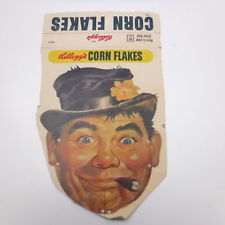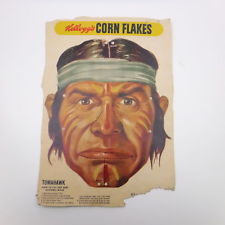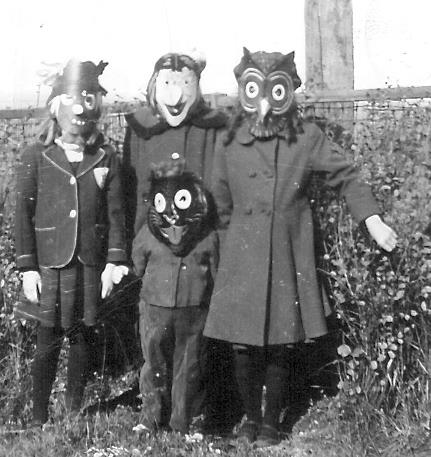EXTRAS
CALENDAR CUSTOMS
CALENDAR CUSTOMS
HALLOWE'EN
formerly COLCANNON NIGHT and SNAP APPLE NIGHT
October 31st
by Gail Hussey-Weir
Created October 2019
formerly COLCANNON NIGHT and SNAP APPLE NIGHT
October 31st
by Gail Hussey-Weir
Created October 2019
Hallowe'en Night is celebrated on October 31 and is said to have originated as "a Celtic celebration marking the division of the light and dark halves of the year, when the boundary between the living and the dead was at its thinnest." The Canadian Encyclopedia says "the wearing of disguises to ward off ghosts and offering food to appease malevolent spirits were brought to Canada in the mid-to-late 1800s by Irish and Scottish immigrants." I have asked people, who were born early-to-mid 20th century and from various parts of Newfoundland, when the tradition of going door-to-door begging for treats began, and they all said that it was sometime in the 1950s. So that aspect of our tradition may have been brought here by Canadian soldiers who were stationed here during World War II. Prior to that, Hallowe'en on Bell Island was celebrated more as a community gathering, which can be seen below in the events noted in the Daily News down through the years:
In 1925, a Masquerade ball was held at the Scotia office in celebration of Hallowe'en. First ladies' prize was won by Mrs. W. Lindsay [Clarice] as "The Queen of Hearts," and the gents' prize by her husband [William Lindsay] as a Dutchman. "The Sporty Few" also held a Hallowe'en party in costume. Prize winners were Miss May Ezekiel as "Hallowe'en" and Ford Basha as "Yes, we have no bananas."
In 1927, the Masonic Society held a Hallowe'en party where music was provided by a cabinet gramophone. (Up to this time, music was always live.)
In 1931, a Hallowe'en dance was held in the Masonic Hall with music being provided by the Melodians' Orchestra. The prizes were won by Annie Carroll and George Basha.
In 1932, at a masquerade dance in the Star Hall in honour of Hallowe'en, Leo Kennedy won first prize as "Frankenstein." Mabel Peddle took the first ladies' prize as "Prosperity is Coming." Veronica Farrell and John Conway took second prizes. The judges were Mr. and Mrs. R.R. Costigan, Mrs. Charles Cohen and P.T. Murphy. The New Melodians Orchestra (Ben Glick, Mary Petrie, Martha Carbage, and A.S. Murray), who were dressed in Russian costumes, supplied the music. Winners of the various dances were Emma Hutchings and Fred Murrin, Hazel Smith and Eugene Kennedy, Eileen Kehoe and Tom Searle, Hilda Bennett and Richard Penney.
In 1937, at a Hallowe'en dance in the Masonic Hall under the auspices of the Tennis Club, the elimination dance was won by Doris Foote and Gordon Martin.
Most of the following memories of Colcannon Night (also called Snap Apple Night) and Hallowe'en on Bell Island are excerpts from interviews done in the 1990s:
In 1925, a Masquerade ball was held at the Scotia office in celebration of Hallowe'en. First ladies' prize was won by Mrs. W. Lindsay [Clarice] as "The Queen of Hearts," and the gents' prize by her husband [William Lindsay] as a Dutchman. "The Sporty Few" also held a Hallowe'en party in costume. Prize winners were Miss May Ezekiel as "Hallowe'en" and Ford Basha as "Yes, we have no bananas."
In 1927, the Masonic Society held a Hallowe'en party where music was provided by a cabinet gramophone. (Up to this time, music was always live.)
In 1931, a Hallowe'en dance was held in the Masonic Hall with music being provided by the Melodians' Orchestra. The prizes were won by Annie Carroll and George Basha.
In 1932, at a masquerade dance in the Star Hall in honour of Hallowe'en, Leo Kennedy won first prize as "Frankenstein." Mabel Peddle took the first ladies' prize as "Prosperity is Coming." Veronica Farrell and John Conway took second prizes. The judges were Mr. and Mrs. R.R. Costigan, Mrs. Charles Cohen and P.T. Murphy. The New Melodians Orchestra (Ben Glick, Mary Petrie, Martha Carbage, and A.S. Murray), who were dressed in Russian costumes, supplied the music. Winners of the various dances were Emma Hutchings and Fred Murrin, Hazel Smith and Eugene Kennedy, Eileen Kehoe and Tom Searle, Hilda Bennett and Richard Penney.
In 1937, at a Hallowe'en dance in the Masonic Hall under the auspices of the Tennis Club, the elimination dance was won by Doris Foote and Gordon Martin.
Most of the following memories of Colcannon Night (also called Snap Apple Night) and Hallowe'en on Bell Island are excerpts from interviews done in the 1990s:
Edward (Ned) Kent, born Lance Cove, 1905:
"There was no Hallowe'en when I was growing up, nothing like that. We'd have Colcannon, that was a wonderful night. There was the RC school on top of the hill (in Lance Cove), and the Church of England one below on the beach. And we'd go back and forth to different dances. Go to Freshwater and have Colcannon one year, and the next year they'd have it at another school. That was a time, held at night. The women would make the colcannon, all vegetables put together. And then Snap Apple Night, that was another crazy racket. You'd hang the apple up and swing it back and forth and the first fella that could take a bite, he owned the apple. They were only a cent each at that time. Then they'd have a tub of water and put two or three apples in it. A girl would get down and lean over the tub and dive down into the water to try and catch the apple in her teeth. She'd drive the apple right down; her neck would be right down in the water trying to get an apple. Then somebody would push her just as she'd go to grab the apple. That was a racket, that was. That would be held in homes. They would have it set up in the back porch. A crowd would get around trying to get an apple. You'd have it at one house one night and then at another house another night. They'd have all kinds of old games. And then they'd have pancakes and they'd put something into them: a horseshoe nail or pin or something like that [to tell your fortune]."
Ned Kent remembered Snap Apple Night and Colcannon Night as different events, but the late Larry Dohey, on his "Archival Moments" website, found evidence of the two being combined into one night of activities, and they were held on what we now celebrate as Hallowe'en. He reported that "long before Trick or Treating or Halloween got established in Newfoundland, in many communities the night of October 31 was referred to as Colcannon (also Cauld Cannon) Night. On what is now All Hallows’ Eve or Halloween, friends would be invited to a dinner of colcannon, a mixture of hash of various vegetables, and sometimes meat. The surprise of the dinner was that there were four objects hidden in the large dish of colcannon, a ring, a coin, an old maid’s thimble, and a bachelor’s button. Each object had great symbolic significance. Whoever found the ring would marry soon. To the coin-holder, riches would accrue, while celibacy awaited both the thimble-getter and button- holder." Snap Apple was a game played by children at these parties, while the adults would have dances.
*********************************************************
Jean (Lindsay) Alcock, born 1913, and Elizabeth (Lindsay) Palmer, born 1932, both grew up Scotia Ridge:
At Hallowe'en we used to have Hallowe'en parties at the house. We would bob for apples and things like that. We never went door to door Trick-or-Treating. You might go next door, but that's about all.
*********************************************************
Pat Mansfield, born Bell Island 1924:
Never knew anything about Hallowe'en. We'd see pumpkins scooped out, but never go to people's doors. We'd have Colcannon.
*********************************************************
Gail Hussey-Weir, born Bell Island 1948:
My first Hallowe'en memories were about age 8 or 9 (1956 or so). The only "costumes" we had were cardboard mask cut-outs from the backs of Kellogg's Corn Flakes boxes. (Fleming's Drug Store sold little packages of witch and ballerina crepe-paper "costumes" that were pretty pathetic in our weather.) We didn't go out until it got dark. It would be pitch dark heading out Armoury Road with a few other kids, going to unlit back doors, frightened to death of how we would be received. People always seemed surprised to see us. Some didn't seem to know what we wanted. I don't believe we used the words "trick or treat." I think we said, "Any jannies allowed in." (Not that we wanted to go in. We just wanted to get some candy and dash to the next house. It wasn't until I was a teenager in the early 60s taking my little sister around on Hallowe'en that I first heard the phrase "Trick or Treat" used.) But there was not much candy given out back in the 50s. One lady divided an apple into quarters for us. I recall seeing small gangs of boys pass us in the dark with palings off fences and other stuff they were collecting for Bonfire Night.
One of our neighbours used to hang an apple on a string from the kitchen door frame. We'd take turns trying to catch the swinging apple in our teeth. Ouch!
"There was no Hallowe'en when I was growing up, nothing like that. We'd have Colcannon, that was a wonderful night. There was the RC school on top of the hill (in Lance Cove), and the Church of England one below on the beach. And we'd go back and forth to different dances. Go to Freshwater and have Colcannon one year, and the next year they'd have it at another school. That was a time, held at night. The women would make the colcannon, all vegetables put together. And then Snap Apple Night, that was another crazy racket. You'd hang the apple up and swing it back and forth and the first fella that could take a bite, he owned the apple. They were only a cent each at that time. Then they'd have a tub of water and put two or three apples in it. A girl would get down and lean over the tub and dive down into the water to try and catch the apple in her teeth. She'd drive the apple right down; her neck would be right down in the water trying to get an apple. Then somebody would push her just as she'd go to grab the apple. That was a racket, that was. That would be held in homes. They would have it set up in the back porch. A crowd would get around trying to get an apple. You'd have it at one house one night and then at another house another night. They'd have all kinds of old games. And then they'd have pancakes and they'd put something into them: a horseshoe nail or pin or something like that [to tell your fortune]."
Ned Kent remembered Snap Apple Night and Colcannon Night as different events, but the late Larry Dohey, on his "Archival Moments" website, found evidence of the two being combined into one night of activities, and they were held on what we now celebrate as Hallowe'en. He reported that "long before Trick or Treating or Halloween got established in Newfoundland, in many communities the night of October 31 was referred to as Colcannon (also Cauld Cannon) Night. On what is now All Hallows’ Eve or Halloween, friends would be invited to a dinner of colcannon, a mixture of hash of various vegetables, and sometimes meat. The surprise of the dinner was that there were four objects hidden in the large dish of colcannon, a ring, a coin, an old maid’s thimble, and a bachelor’s button. Each object had great symbolic significance. Whoever found the ring would marry soon. To the coin-holder, riches would accrue, while celibacy awaited both the thimble-getter and button- holder." Snap Apple was a game played by children at these parties, while the adults would have dances.
*********************************************************
Jean (Lindsay) Alcock, born 1913, and Elizabeth (Lindsay) Palmer, born 1932, both grew up Scotia Ridge:
At Hallowe'en we used to have Hallowe'en parties at the house. We would bob for apples and things like that. We never went door to door Trick-or-Treating. You might go next door, but that's about all.
*********************************************************
Pat Mansfield, born Bell Island 1924:
Never knew anything about Hallowe'en. We'd see pumpkins scooped out, but never go to people's doors. We'd have Colcannon.
*********************************************************
Gail Hussey-Weir, born Bell Island 1948:
My first Hallowe'en memories were about age 8 or 9 (1956 or so). The only "costumes" we had were cardboard mask cut-outs from the backs of Kellogg's Corn Flakes boxes. (Fleming's Drug Store sold little packages of witch and ballerina crepe-paper "costumes" that were pretty pathetic in our weather.) We didn't go out until it got dark. It would be pitch dark heading out Armoury Road with a few other kids, going to unlit back doors, frightened to death of how we would be received. People always seemed surprised to see us. Some didn't seem to know what we wanted. I don't believe we used the words "trick or treat." I think we said, "Any jannies allowed in." (Not that we wanted to go in. We just wanted to get some candy and dash to the next house. It wasn't until I was a teenager in the early 60s taking my little sister around on Hallowe'en that I first heard the phrase "Trick or Treat" used.) But there was not much candy given out back in the 50s. One lady divided an apple into quarters for us. I recall seeing small gangs of boys pass us in the dark with palings off fences and other stuff they were collecting for Bonfire Night.
One of our neighbours used to hang an apple on a string from the kitchen door frame. We'd take turns trying to catch the swinging apple in our teeth. Ouch!
In Grade 4 (1957), we had a classroom Hallowe'en party with a prize for best costume. I dressed as a hobo with my "lunch" tied in a red bandana hanging from a broom handle over my shoulder. Perhaps I got the idea from the Hobo mask on the cereal box (see photo below left). I won first prize and the teacher took me around to show the other classrooms my costume.
I also recall playing bob-for-the-apple at school Hallowe'en parties. There would be some apples floating in a tub of water. We would kneel down and try to bit into an apple with our hands behind our backs; pretty hard to do!
I also recall playing bob-for-the-apple at school Hallowe'en parties. There would be some apples floating in a tub of water. We would kneel down and try to bit into an apple with our hands behind our backs; pretty hard to do!
* * *
|
Eileen (Kent) Kavanagh, born Bell Island, 1947: I lived down St. Pat's Lane and we trick or treated as far back as I can remember. We got a lot of those Molasses Halloween candy, rockets and barrel apples that were rock hard. I remember a couple years Mom making toffee apples to hand out and when she stopped everyone was disappointed. We always had a Halloween party at school. We brought snacks and played BINGO. I remember parties at home too where we bobbed for apples and tried to bite apples hanging on a string in the archway without using our hands. Here's a picture of my sisters & I in masks from Flemings Drug store around 1954. I think the masks were 10¢ each. I'm the scarecrow on the left. |


